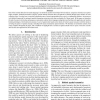Free Online Productivity Tools
i2Speak
i2Symbol
i2OCR
iTex2Img
iWeb2Print
iWeb2Shot
i2Type
iPdf2Split
iPdf2Merge
i2Bopomofo
i2Arabic
i2Style
i2Image
i2PDF
iLatex2Rtf
Sci2ools
LREC
2010
2010
Spatial Role Labeling: Task Definition and Annotation Scheme
One of the essential functions of natural language is to talk about spatial relationships between objects. Linguistic constructs can express highly complex, relational structures of objects, spatial relations between them, and patterns of motion through spaces relative to some reference point. Learning how to map this information onto a formal representation from a text is a challenging problem. At present no well-defined framework for automatic spatial information extraction exists that can handle all of these issues. In this paper we introduce the task of spatial role labeling and propose an annotation scheme that is language-independent and facilitates the application of machine learning techniques. Our framework consists of a set of spatial roles based on the theory of holistic spatial semantics with the intent of covering all aspects of spatial concepts, including both static and dynamic spatial relations. We illustrate our annotation scheme with many examples throughout the pape...
Education | LREC 2010 | Spatial | Spatial Relations | Spatial Roles |
| Added | 29 Oct 2010 |
| Updated | 29 Oct 2010 |
| Type | Conference |
| Year | 2010 |
| Where | LREC |
| Authors | Parisa KordJamshidi, Martijn van Otterlo, Marie-Francine Moens |
Comments (0)

